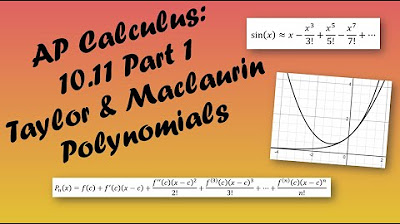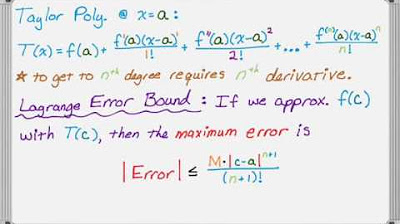Taylor polynomial remainder (part 1) | Series | AP Calculus BC | Khan Academy
TLDRThe video script discusses the concept of Taylor polynomials, a method for approximating functions. It explains how Taylor polynomials are derived by matching the derivatives of the polynomial with those of the function at a given point 'a'. The script introduces the remainder function, which represents the error of the approximation, and explores its properties, including its zero value at 'a' and its derivatives up to the Nth order. The focus then shifts to the N+1th derivative of the error function, which is key for bounding the error and understanding the approximation's accuracy as one moves away from 'a'. The video sets the stage for further discussion on bounding the error in the subsequent episode.
Takeaways
- 📈 The concept of Taylor polynomial is introduced as a tool to approximate functions, centered around a specific point 'a'.
- 🔢 Taylor polynomials are constructed such that their derivatives up to the Nth degree match those of the function being approximated at point 'a'.
- 🌐 The approximation improves as more terms are added to the polynomial, resulting in a better fit to the function's curve.
- 🎯 The error or remainder function is defined as the difference between the actual function and its Taylor polynomial approximation.
- 📍 At the center point 'a', the error function is zero because the polynomial and the function coincide exactly.
- 🚀 The derivatives of the error function up to the Nth degree are also zero at point 'a', as they match the corresponding derivatives of the function.
- 🌟 The N plus oneth derivative of the error function is equal to the N plus oneth derivative of the function, as the polynomial is of Nth degree and its higher derivatives are zero.
- 📊 The goal of the analysis is to find a way to bound the error function to understand the quality of the approximation as one moves away from point 'a'.
- 🧮 The bounding of the error function could potentially allow for further calculations, such as integration, to gain insights into the behavior of the original function.
- 🔍 The discussion sets the stage for future analysis, aiming to determine an upper bound on the error to gauge the accuracy of the Taylor polynomial approximation.
Q & A
What is the main concept discussed in the transcript?
-The main concept discussed in the transcript is the Taylor polynomial, a method used to approximate functions with a polynomial centered around a specific point 'a'.
How is the Taylor polynomial related to the function it approximates?
-The Taylor polynomial is constructed such that its derivatives up to the Nth degree evaluated at 'a' are equal to the corresponding derivatives of the function evaluated at 'a'. This makes the polynomial an accurate approximation of the function, especially near the point 'a'.
What is the definition of the error function in the context of the Taylor polynomial?
-The error function is defined as the difference between the actual function f(x) and its Taylor polynomial approximation P(x) at any given x. It measures how well the polynomial fits the curve of the function.
What is a key property of the error function at 'a'?
-A key property of the error function at 'a' is that it is equal to zero. This is because the Taylor polynomial and the function are identical at the center point 'a', making their derivatives and the function values at 'a' the same.
How do the derivatives of the error function behave at 'a'?
-The derivatives of the error function up to the Nth degree are equal to zero at 'a'. This is a direct result of the construction of the Taylor polynomial, where the derivatives of the polynomial match those of the function at 'a'.
What happens when we take the N plus oneth derivative of the error function?
-When we take the N plus oneth derivative of the error function, it is equal to the N plus oneth derivative of the original function minus the N plus oneth derivative of the Nth degree polynomial. Importantly, the N plus oneth derivative of an Nth degree polynomial is always zero, regardless of x.
Why is the N plus oneth derivative of the Nth degree polynomial zero?
-The N plus oneth derivative of an Nth degree polynomial is zero because, by definition, an Nth degree polynomial has N terms, and differentiating it N times will result in a polynomial of degree 0 (a constant), which is zero when the polynomial is centered at the point of differentiation.
What is the significance of bounding the error function?
-Bounding the error function is significant because it allows us to estimate how accurate our Taylor polynomial approximation is, especially as we move away from the center point 'a'. An upper bound on the error gives us an idea of the maximum discrepancy between the function and its approximation.
How can we potentially use the bounded error function?
-If we can determine an upper bound on the error function, we can integrate it to find a range for the accumulated error over an interval. This can help us understand the overall accuracy of the Taylor polynomial approximation over a range of x values and potentially refine our approximation if necessary.
What is the role of calculus in understanding the Taylor polynomial and its error?
-Calculus plays a crucial role in understanding the Taylor polynomial and its error. It is used to find the derivatives of the function and the polynomial, which are essential in constructing the Taylor polynomial. Additionally, calculus is used to analyze the behavior of the error function, such as finding its derivatives and bounding its magnitude.
What will be the focus of the next video based on the transcript?
-The next video will likely focus on bounding the error function of the Taylor polynomial. It will explore methods to determine an upper bound on the error, which will help in understanding the accuracy of the polynomial approximation for different values of x, particularly as x moves away from the center point 'a'.
Outlines
📚 Introduction to Taylor Polynomials
This paragraph introduces the concept of Taylor polynomials as a method to approximate functions. It explains the process of centering the polynomial around a point 'a' and how the polynomial is constructed by equating the derivatives of both the function and the polynomial up to the degree of the polynomial. The paragraph also introduces the notation for the Taylor polynomial, including the subscript 'N' to denote the degree of the polynomial and the subscript 'a' to denote the center. The approximation becomes more accurate as more terms are added, and the video aims to explore how well the polynomial fits the function as one moves away from the center 'a'.
🔢 Error Function and its Derivatives
This paragraph delves into the error function, which measures the difference between the actual function and its Taylor polynomial approximation at any given point 'x'. It emphasizes that the error function at the center 'a' is zero since the polynomial and the function coincide there. The paragraph then discusses the derivatives of the error function up to the 'Nth' degree, showing that they are also zero at 'a' due to the matching derivatives of the polynomial and the function. This property is crucial for bounding the error function in future analysis.
🌟 Beyond the Nth Derivative and Future Analysis
The final paragraph explores what happens when considering the 'N plus oneth' derivative of the error function. It explains that the 'N plus oneth' derivative of an 'Nth' degree polynomial is zero, which implies that the 'N plus oneth' derivative of the error function is equal to the 'N plus oneth' derivative of the function itself, as the polynomial's contribution drops out. The paragraph sets the stage for future analysis, aiming to bound the magnitude of the error function to understand the quality of the polynomial approximation, especially as one moves away from the center 'a'.
Mindmap
Keywords
💡Taylor Polynomial
💡Derivatives
💡Approximation
💡Error Function
💡Degree of the Polynomial
💡Center Point 'a'
💡Nth Derivative
💡Remainder
💡Polynomial Evaluation
💡Bounds
Highlights
The introduction of the concept of approximating a function f(x) using a Taylor polynomial centered at a specific point a.
The requirement for the derivatives of the polynomial up to and including its degree to match the derivatives of the function at the point a.
The definition of the Taylor polynomial approximation, P(x), as a function that matches f(a) and its derivatives up to the Nth degree at point a.
The explanation that the Taylor polynomial P(x) evaluated at a equals the function f(x) evaluated at a, hence the error at a is zero.
The derivation of the remainder function (error function) as the difference between the function f(x) and its approximation P(x) at any given x.
The property that the error function at a is equal to zero, as the polynomial and the function coincide at the center point a.
The discussion on the derivative of the error function evaluated at a, which is also zero up to the Nth derivative due to the matching of derivatives at a.
The insight that taking the N plus oneth derivative of the error function results in a non-zero value, which is the (N+1)th derivative of the function minus the zero value.
The potential for using calculus to integrate the error bounds back to the original function to gain further insights.
The mention of bounding the error function to understand the quality of the approximation as one moves away from the center point a.
The explanation that the higher the degree of the polynomial, the better the fit to the curve, especially further away from the center point a.
The introduction of the remainder term in the Taylor series approximation, which captures the difference between the actual function value and the polynomial approximation.
The importance of understanding the error term in practical applications, as it provides a measure of the accuracy of the Taylor polynomial approximation.
The potential continuation of the discussion into the next video, indicating a deeper exploration of bounding the error function.
The mention of the Nth degree polynomial centered at a as an approximation tool that becomes increasingly accurate with more terms.
The explanation of how the Taylor polynomial approximation works and its mathematical foundation, providing a clear understanding of the process.
Transcripts
5.0 / 5 (0 votes)
Thanks for rating:





